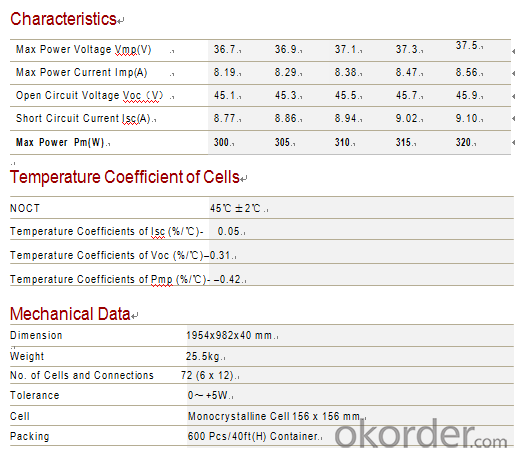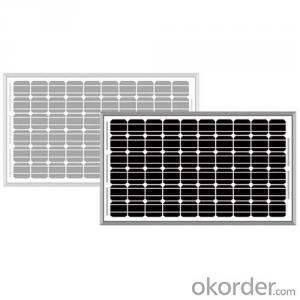MONO-CRYSTALLINE SOLAR PANEL 300W
- Loading Port:
- China Main Port
- Payment Terms:
- TT OR LC
- Min Order Qty:
- -
- Supply Capability:
- -
OKorder Service Pledge
Quality Product, Order Online Tracking, Timely Delivery
OKorder Financial Service
Credit Rating, Credit Services, Credit Purchasing
You Might Also Like

High efficiency silicon based solar cells and modules,which are individually characterized and electronically matched before interconnection and laminated with toughened glass,EVA and TPT of high quality. Through strict selection of raw materials, stringent quality control and rigorous test. Our pv mdoule have always committed to higher efficiency, more stable and better cost performance products. Our pv module is no less than 90% within 10yrs and no less than 80% within 25yrs
- Q:I have the wattage of solar panel but i dont know about the voltage amp; current rating of it. Plz explain me about the voltage rating of solar panel.
- The voltage rating and current rating are part of the specifications for the panel. You will have them listed on the spec sheet. The voltage number is usually the open circuit voltage of the panel, the voltage with no load. The current number is the short circuit current of the panel. In use, you need special electronics, called a Maximum Power Tracker (MPT) controller, which adjust the load to get the most power from the panel, and adjust the voltage output via a DC-DC converter to the optimal conditions to charge the attached battery. how to take batteries as per solar wattage ? sorry, don't understand this.
- Q:Can solar panels be used on boats or marine applications?
- Yes, solar panels can be used on boats or marine applications. They are a popular and effective source of renewable energy for powering various systems on boats, such as lights, navigation equipment, and even charging batteries. Solar panels are lightweight, durable, and designed to withstand harsh marine environments, making them suitable for use on boats and other marine applications.
- Q:I am building a solar car for the energy wiz competition and I was wondering how I could possibly get my solar panel to shift sideways
- having solar panels move like that on a mobile platform is inadvisable -- especially if there is a dynamic wind load resulting from the motion of the mobile platform. Even having a tilt mechanism is dubious at best. think of what limited marginal gain would be gained by mounting a small solar panel on the moon roof of a car. (ultimately, the best answer is to turn the car so that it's angle to the sun is optimal -- but the road/travel direction constraints are what ultimately prohibit that.) while there are ways to build sliding panels, the weight constraints would interfere with your weight/thrust ratios to the point of futility. if you really need that panel somewhere else, don't slide it out of the way, just buy another panel and mount it there. it's more expensive, but it's actually the cheapest solution in terms of design on a mobile platform.
- Q:Do solar panels require a specific orientation or angle for optimal performance?
- Yes, solar panels do require a specific orientation and angle for optimal performance. Generally, it is recommended to install solar panels facing south and at an angle equal to the latitude of the installation location. This allows the panels to receive maximum sunlight throughout the day, maximizing their energy production. However, panels can still generate electricity when facing other directions or at different angles, although their efficiency may be slightly reduced.
- Q:Can solar panels be used in areas with high levels of vandalism?
- Yes, solar panels can be used in areas with high levels of vandalism. However, it is important to implement additional security measures, such as installing anti-vandalism devices, using tamper-proof mounting systems, and employing surveillance systems to deter potential vandals. Regular maintenance and quick repairs are also crucial to ensure the optimal functioning of solar panels in such areas.
- Q:The intensity of sunlight at the distance of the Earth's orbit is 380 W/m2. An Earth-orbiting satellite has a solar panel that measures .35 m by 4.86 m, which converts solar energy to electrical energy with an efficiency of 26%. In one hour, how much electrical energy does the panel produce? Assume that the satellite's attitude control jets keep the panel oriented perpendicular to the incoming sunlight.
- This is pretty much an exercise in knowing units and dimensional analysis. Watts are in Joules/second. So every second a square with the area(meters^2) of meter^2 receives 380 joules from the sun. In your case the square is the solar panel. So find the area of the solar panel in m^2. If you multiply area times intensity you can see that the meters cancel out and you are left with Watts(J/s). Since you want the Joules received in an hour you again multiply by how many seconds are in an hour. Leaving you with joules. What you have now is the total energy, but your solar panel is only 26% efficient, so just multiply by .26 and you will have your energy.
- Q:Photosynthesis is fairly inefficient, but efficient enough to power all life on earth.
- Si is a neutral semiconductor, and, when combined with the other metals in the solar panel, it the panel polarizes, and releases electrons form one end, and accepts them back at the other. Like a water pump. Mg is not the major ingredient because it doesn't have the easily altered semiconductor properties Si does. To put it simply, Si is easier to work with.
- Q:Can solar panels be used in areas with limited space?
- Yes, solar panels can be used in areas with limited space. There are various types of solar panels available, including smaller and more compact ones, that can be installed in limited spaces such as rooftops, balconies, or even on walls. Additionally, advancements in solar technology have allowed for the development of flexible and thin-film solar panels that can be integrated into various surfaces, further maximizing space utilization.
- Q:Can solar panels be used in areas with high levels of chemical pollutants?
- Yes, solar panels can be used in areas with high levels of chemical pollutants. While it is true that pollutants can potentially affect the efficiency and performance of solar panels, proper maintenance and cleaning can mitigate these effects. Additionally, advancements in solar panel technology have made them more resilient to environmental factors, including chemical pollutants.
- Q:I have made a 5v dc 52watt solar panel and I going to be trying to charger 4 2v dc 55ah batteries. I get about 6 hours of sun on my panel. Spec below, is that a big enough panel to charge the batteries???I have 30 3x6 solar cells wired together Cell Specifications: (Watts): .75 Wp (Amps): 3.5 Imax (Volts): 0.5 V max which is where I got my 5g 52watt max (if math is wrong plz tell me) The Battery type: 2Volt 55.0ah NB Sealed Lead Acid Battery. I am using a mppt solar charger.
- OK your math on the solar panel looks correct, but you are missing some critical information. What is the load on your batteries and for how long is this load being applied. Calculate the amp-hour load to see if your solar panel can recharge your batteries with the amount of sun light available. A safe engineering standard is to have twice as much capability as required. If you have a 200 amp load for 7.5 minutes, this would be a 25 amp-hour discharge and will take your solar panel over 7 hours to recharge your batteries. Your solar panel can easily charge the batteries up to full capacity with out any load on the batteries, if the batteries are 50% discharged, this will take about 32 hours. CAUTION! I am assuming that you are hooking the batteries up in a parallel connection, that will give you over 200 amps of current. You should charge each battery up to full charge before you connect them together, if they are not at the same exact voltage when you connect them together, they will self adjust so that each battery is at the same voltage level, at 55 amps this could be a very large spark. Each cell, there are six (6) cells in a 2 volt battery, should be at 2.7 to 2.2 volts DC per cell at full charge. Make sure your battery has a voltage 3.02 to 3.26 volts open circuit or no load. This should be full charge if your batteries do not have this voltage level, say one battery is at 0 volts DC, it could have a dead or shorted cell. DO NOT use this battery until you can get it to hold a 3.02 to 3.26 volt DC level.
1. Manufacturer Overview |
|
|---|---|
| Location | |
| Year Established | |
| Annual Output Value | |
| Main Markets | |
| Company Certifications | |
2. Manufacturer Certificates |
|
|---|---|
| a) Certification Name | |
| Range | |
| Reference | |
| Validity Period | |
3. Manufacturer Capability |
|
|---|---|
| a)Trade Capacity | |
| Nearest Port | |
| Export Percentage | |
| No.of Employees in Trade Department | |
| Language Spoken: | |
| b)Factory Information | |
| Factory Size: | |
| No. of Production Lines | |
| Contract Manufacturing | |
| Product Price Range | |
Send your message to us
MONO-CRYSTALLINE SOLAR PANEL 300W
- Loading Port:
- China Main Port
- Payment Terms:
- TT OR LC
- Min Order Qty:
- -
- Supply Capability:
- -
OKorder Service Pledge
Quality Product, Order Online Tracking, Timely Delivery
OKorder Financial Service
Credit Rating, Credit Services, Credit Purchasing
Similar products
New products
Hot products
Related keywords



























